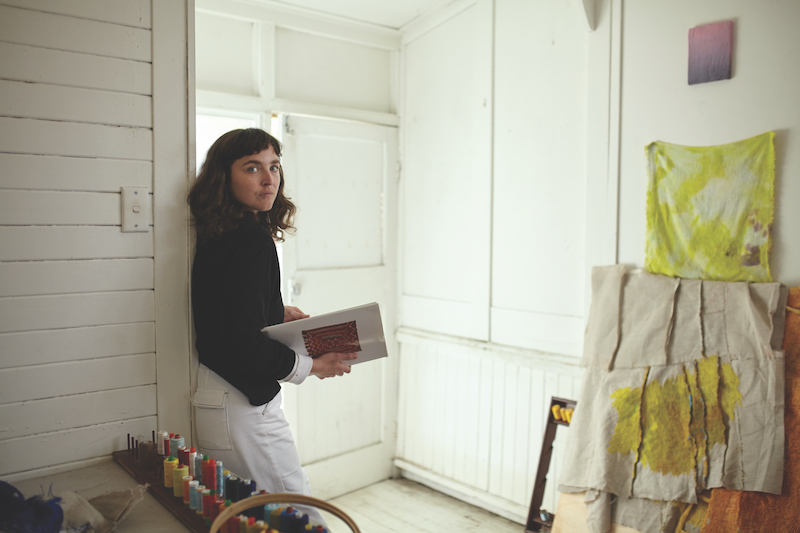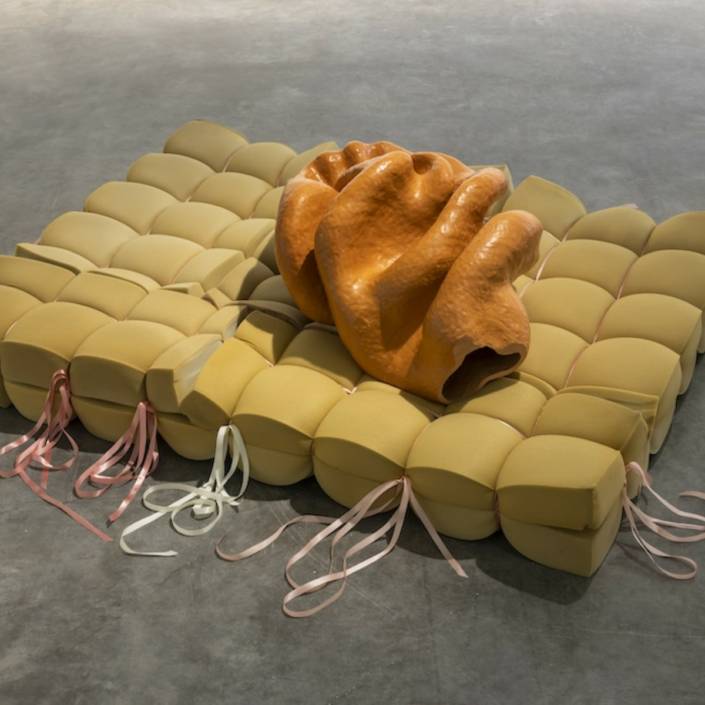Teelah George: Alternating Currents
Teelah George’s embroidery works are built stitch by stitch, her paintings layer by layer – unravelling stories that are at once deeply personal and profoundly universal.
Words: Jane O’Sullivan
Photography: Bianca Woolhouse
IN THE WORLD WAS WHOLE, essayist Fiona Wright writes about philosophies of time. “Transcendent time is that rare, luminous time of important or startling events – like travel,” she pens. “It is time that breaks the rules of everyday life. Immanent time, however, is the rules – it is regular, unruffled, it passes mostly without us noticing. But we need immanent time, to rest, to reflect, to maintain our sense of self.” Which is to say, our routines are what make us.
Teelah George is no stranger to repetition. Her embroideries are shimmering fields of colour, built up stitch by stitch over many long hours. Despite the time taken to make them, they often feel like drawings, with the stitches forming drifts of tiny lines across the linen.
In one new large-scale embroidery, The Weight (2018-19), George has introduced a fresh element of repetition. Black and white stripes fall vertically down the cloth, though they are more like rivulets than neat bars. They are optically confusing. There is no easy foreground or background to latch onto, and the blacks fluctuate in intensity, dissolving into deep greens and maroons.
George does not like to plan or compose her works. She prefers to work intuitively, responding to the materials and the moment. In The Weight, each line seems to build on and react to the one before. There is a sense of layering and accumulation, pulled taut by the brass plates suspended from the base of the work. “A lot of what that has to do with is weight and gravity, both physical and also metaphorical,” she says.
And George has had a lot weighing on her. The past year has been brutal, a time she describes as one of intense change and trauma.
“I needed to get away from Perth for a bit,” she says. She spent just over six months travelling, including to Paris and Belfast. Painting was not practical, but the embroidery was more portable. “There’s something really interesting about the fact that I can even abandon the studio, because I am such a studio artist,” she says. “It was just what I needed; what the work needed.”
As she travelled, she continued her ongoing Sky Piece series, recording the sky in thread. For her, this series is a “Sisyphean pursuit that will never really be possible but is something that I’m always going to try and do.” An earlier Sky Piece was exhibited in Primavera at the Museum of Contemporary Art in 2017. It was an expansive, springtime blue. This new piece, a patchwork of the sky as seen from Perth, Paris and Belfast, is more muted.
George also took the opportunity to visit churches and museums and see the Bayeux Tapestry in Normandy. These were moving experiences for an artist deeply interested in time, memory and materiality.
Without planning it, crosses started to emerge in her smaller embroideries. The iconography is abstracted. One is loosely divided into quad- rants. Another looks more like a paper collage, with cut-outs dropped loosely on the corners. These smaller works are also connected by George’s use of carnal reds. “The symbology of using the colour red became something I was compelled to do,” she says.
She is cautious about tying the work to religion. “Faith is a strong word,” she says. But seeing historical objects and having her own experiences with them led her to think- ing about the touchstones that we reach for, particularly in turbulent times. “We all have these objects and, whether they’re religious or not, they have this effect of offering a touchstone to history and time that makes us feel better or feel a part of something.”
These new works have also evolved out of George’s interest in embroidery samplers. She sees them as melancholy objects, explaining that they were not just educational exercises but often given as personal mementoes during times of separation. “It became connected to things I was looking at and things I was thinking about being close to people,” she says.
The idea of transferring emotions onto objects, or using them to seek communion with others, is not new to her. “Well, that’s what art is, right?” she laughs.
In earlier bodies of work, she engaged with archival materials, and showed a sensitivity to the histories already buried within them. In her painting, which she hopes to return to soon, she builds up surfaces in a slow process she’s called reverse archaeology.
As she worked on the striped piece, she also found herself thinking about how to express “symmetry but asymmetry”. In a way, this idea mirrors her experience traveling and the “unfettered” feeling it gave her. It was, she says, “a freeing thing, but at the same time it was essentially homelessly wandering. That can be extraordinarily upsetting, depending on the mood you’re in, but also extremely liberating”.
GEOFF NEWTON
Director, Neon Parc, Melbourne
“Teelah has a very honest response to her subject and her materials,” says Geoff Newton, the director of Neon Parc in Melbourne. “This rawness allows for a direct engagement with her audience. There is a simplicity and economy of colours, motifs and scale.” For him, it recalls some of the abstract expressionists on the fringe of the moment, but what is different about George’s work is the way it comes “from a personal space”.
Newton first saw George’s work in Art Collector, then sought it out in the 2017 Primavera at the Museum of Contemporary Art. Sky Piece “struck me as a work which held attention and didn’t fit in to what a lot of younger contemporary artists were doing. As I learnt more about her approach, I was fascinated and we started working together.”
Newton has now exhibited her work at the Sydney Contemporary and Spring 1883 art fairs, where he was impressed to see how her work was complimented by artists with very different approaches to painting.
In 2017, the same year she was in the MCA’s Primavera showcase of artists under 35, George was also selected as a finalist in the Art Gallery of South Australia’s major Ramsay Art Prize for emerging artists. Her work is held in the Cruthers Collection of Womens Art, as well as the collections of the Museum of Contemporary Art, Art Gallery of Western Australia and Artbank.
“Teelah is a dedicated artist who is developing a very strong body of work,” says Newton. “Her work occupies a very singular space within contemporary art and I feel she has the energy and vision to outlast many of her young peers.”
RICHARD LEWER
Artist
“What I immediately recognised was her determination and her discipline getting into the studio every day. That’s what drew me to her and her work,” says artist Richard Lewer. “She had a real fire burning within her work.”
Lewer is based in Melbourne but met George when he temporarily took a studio at the Fremantle Arts Centre. She was one of a number of young West Australian artists in the studios there, and he immediately recognised the challenges they faced. “In Melbourne, you might be lucky to have curators, directors, collectors, dealers or what- ever come to your studios, but in Fremantle no one would come,” he says. He began what he calls informal crit sessions with the artists, as a way to offer conversation and support. George was open to new ideas. “She wanted to learn a lot, and she wanted to look at how her work could be fed,” recalls Lewer.
They talked about historical societies, other ways of collecting stories and presenting narratives, and also about materials. “She’s a really good drawer and that’s where our connection started as well – through drawing. She hasn’t shown a lot of those drawings, but it was interesting that the drawings became material-like, with tapestries and found thread.”
At the time, Lewer was painting on powder- coated steel and that also led to conversations about different substrates. These days, George often pieces together offcuts and scraps to make the cloth for her embroideries and paintings, and she speaks about the positive impact of Lewer’s mentorship. “I kept on pushing the relevance of being a contemporary artist now. But she responded to that,” he says. “Huge credit to her, she’s done so well.”
This article was originally published in Art Collector issue 89, JUL – SEP, 2019.











